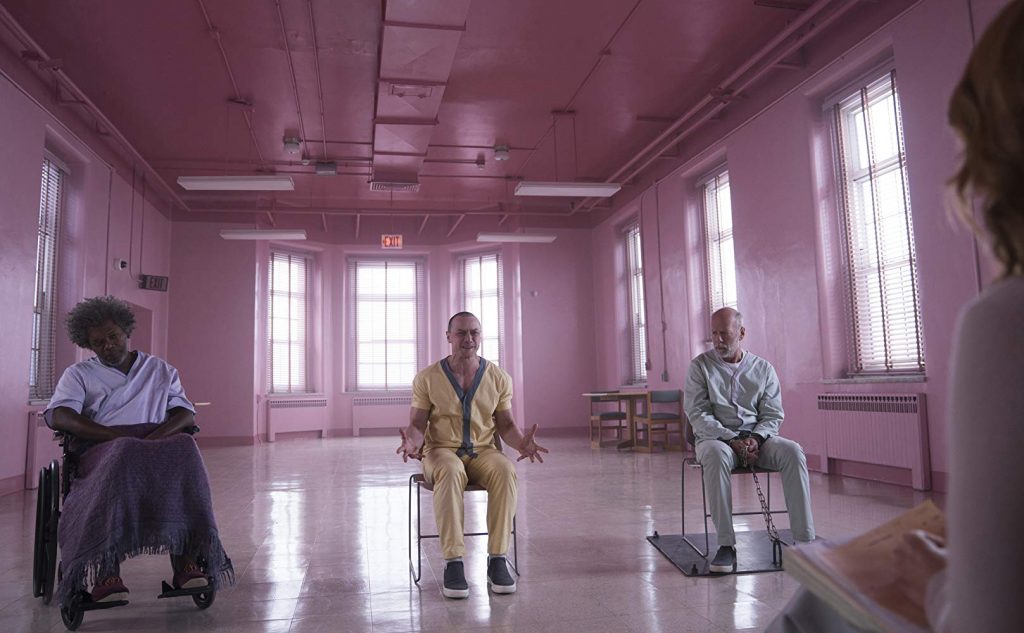Since the 1970s ushered in the era of the blockbuster movie mindset, there have been too many sequels released. It was bad enough when “Smokey and the Bandit II” was released in 1980, followed by an inexplicable and unforgivable third edition three years later, but nowadays it seems hardly a month goes by without at least one cash-in follow-up hitting the nation’s theaters.
This week brings us “Glass,” which has the rare and perhaps unprecedented status of being a sequel to two entirely different films with vastly different storylines by filmmaker M. Night Shyamalan. In one of the most gasp-inducing endings ever to a film, the auteur revealed that Bruce Willis’ character from his 2000 film “Unbreakable” was in the same universe as the insanely evil character nicknamed “The Horde” in 2017’s “Split.”
Willis’ David Dunn was a man who suddenly developed superhuman strength after being the lone survivor of a horrific train crash that killed hundreds in the opening moments of “Unbreakable.” Dunn used those skills — and the fact that he could suddenly see flashbacks of the life of any person he touched, gaining instant insight into whether they were good or evil — to become a vigilante.
“Split” focused on a man with 24 personalities who is nicknamed The Horde (James McAvoy), and has one particularly brutal persona with super-strength known as The Beast. In the film’s closing moments, he evaded capture and fled on an impending rampage across Philadelphia, and Shyamalan revealed that Willis’ Dunn was watching the news coverage on a diner television, vowing to take him down.
The moment sent shock waves through viewers, but especially fanboys, who had long pined for a sequel to “Unbreakable” since that film set up a showdown between Dunn and an evil genius named Elijah Price, played by Samuel L. Jackson. Price called himself “Mr. Glass” as he plotted evil revenge on society via the train derailment and other tragedies because of his bitterness over having a bizarre lifelong condition in which nearly any physical contact could result in broken bones.
“Glass” brings these three wildly original characters together. Dunn is searching for The Horde on his vigilante patrols of Philadelphia’s seedier neighborhoods. He finds The Horde holding four high school cheerleaders hostage in an abandoned loft, and when the two engage in a battle royale while the girls flee, they both wind up captured by the police and thrown into a suburban mental hospital where Glass is already a longtime patient.
It is there that enigmatic psychologist Ellie Staple (Sarah Paulson) brings the odd trio together to conduct an elaborate experiment. She wants to prove that they don’t actually have superpowers and are merely delusional, and has three days to break them of their superheroic mindsets. Yet in those three days, Glass intends to manipulate Dunn and The Horde into carrying out his most vicious crime yet.
Shyamalan employs an unusual story structure in “Glass” to wind up with a film that is both everything a fan of the prior films could want, and yet utterly unexpected. One might assume the showdowns between these three highly gifted individuals would take place on a broad, epic scale across the entire Philadelphia cityscape.
Instead, the film takes a tightly wound, claustrophobic approach as the three supermen are forced to interact within the confines of the hospital’s halls. As Paulson twists the mental screws on each of them, McAvoy once again puts on one of the most incredible acting displays imaginable by seamlessly flowing through the personalities of a perpetual 9-year-old boy, a haughty British woman, and many more within a single speech.
Jackson spends the first half of the film as an apparent zombie who’s heavily sedated by a wide range of psych meds, but then brings a fun sense of menace when he finally springs to life for the second half. Willis is older and more muted than usual here, with a white beard that makes him appear weary to the unwitting world around him while hiding an impressive fury when pushed to his boiling point.
One huge plus in “Glass” is that The Horde doesn’t victimize women throughout the storyline, as he did in “Split,” which had a nasty misogynistic undertone throughout much of the film. Here, he is on a more even playing field in terrorizing men, and Shyamalan further keeps the proceedings more fun (yet still scary) by leaving more of the violence implied and in viewers’ imaginations.
Shyamalan’s shot compositions are impressive to behold throughout, making “Glass” often appear like a living, breathing artwork and inducing grins in this reviewer throughout over his audacious shot and color choices. Bringing it all home is the superb score of West Dylan Thordson, who provides just the right sonic backdrop for the rollercoaster events throughout.
As always, Shyamalan has a couple of surprising twists in store for viewers, with one shocker drawing a loud gasp from this reviewer. But his final move is also an inspiring one, giving the characters within the film and viewers sitting in theaters a jolting reminder that the ability to be a hero for others truly does lie within us all.
Start your day with Always Forward, our award-winning e-newsletter. Get this smart, handpicked selection of the day’s top news, analysis, and opinion, delivered to your inbox. Sign up absolutely free today!

